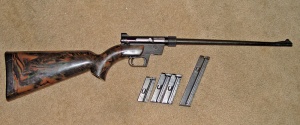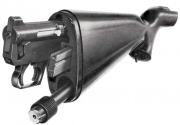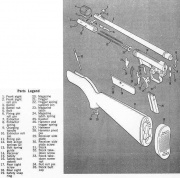AR-7
| AR-7 | |
|---|---|

| |
| Armalite AR-7 survival rifle with 8, 10, and 15-round magazines. | |
|
| |
| Type | Survival rifle |
| Land of Origin | United States |
| Specifications | |
| Length | 889 mm (34.5") |
| Barrel length | 406 mm (16.5") |
| Weight | 1.13 kg (2.5 lbs.) |
| Caliber | .22 |
| Cartridge | .22 Long Rifle |
| Action | straight blowback-operated |
|
| |
| Rate of Fire | Semi-automatic |
| Muzzle velocity | 1,080 ft/s (329 m/s) to 1,280 ft/s (390 m/s) (varies by type of .22 LR cartridge) |
| Effective Range | 100 m |
| Feed | Standard 8-round magazine. 10, 15, 25, and 50 round magazines available. |
| Sights | Aperture rear and drift-adjustable front. |
| Service History | |
| In service | 1959 – Present |
| Production History | |
| Designer | Eugene Stoner |
| Design Date | 1958 |
| Manufacturer | see Production history |
| Unit Cost | US$50-250[1] |
| Variants | Armalite AR-7 Explorer; Charter Arms AR-7 Explorer; Charter Arms Explorer II Pistol; Israeli Pilot's Survival Rifle; Henry U.S. Survival .22 |
Contents |
History & design
The prototype of what would become the AR-7 was designed by Eugene Stoner at ArmaLite Inc., a division of Fairchild Aircraft. The rifle shares some of the features of the bolt-action AR-5, another rifle designed by Stoner for ArmaLite and adopted by the United States Air Force in 1956 as the MA-1.[2] The MA-1 was intended to replace the M4 Survival Rifle and the M6 Aircrew Survival Weapon which was a superimposed ("over-under") twin-barrel rifle/shotgun chambered in .22 Hornet and .410 bore, using a break-open action. The AR-5 had the advantage of repeat fire over the then-standard M6, using the same .22 Hornet cartridge. When the AR-5 was adopted as the MA-1 but was not placed in issue due to the numbers of M4 and M6 survival weapons in USAF inventory, ArmaLite used the research and tooling for the AR-5 in developing the AR-7 for the civilian market.[3]
The AR-7 uses a blowback semi-automatic action in .22 Long Rifle but retains the AR-5/MA-1 feature of storing the disassembled parts within the hollow stock, which is filled with plastic foam and capable of floating.[4][5] Like the bolt-action AR-5, the AR-7 was designed as a survival rifle for foraging small game for food. The AR-7 is constructed primarily of aluminum, with plastic for the stock and buttcap. Even the barrel is aluminum (in later production composite material), using a rifled steel barrel liner.[6] The AR-7 measures 35 inches overall when assembled. It disassembles to four sections (barrel, action, stock, and magazine), with the four parts storing inside the plastic stock measuring 16 inches long. The rifle weighs 2.5 pounds light enough for convenient backpacking. The rear sight is a peep sight, which comes on a flat metal blade with an aperture (in later production two different size apertures), and is adjustable for elevation (up-down). The front sight is adjustable for windage (side-side). Accuracy is sufficient for hunting small game at ranges to 50 yards.Criticisms
|
|
Armalite sold the design to Charter Arms in 1973. According to some accounts posted by enthusiasts, this is where quality began to deteriorate.[7] Barrels were said to have a tendency to warp. Other sources state that the first production at Charter had problems which were corrected in later production runs.[3] Since Charter Arms sold the design and rights to Henry Repeating Arms in 1980, the Henry AR-7 has regained a reputation for reliability.
Production history
(Summary of information available in The Blue Book of Gun Values)
- 1959-1973: ArmaLite
- 1973-1990: Charter Arms
- 1990-1997: Survival Arms, Cocoa, FL
- 1997–Present: Henry Repeating Arms Co., Brooklyn, NY
- 1998-2004: AR-7 Industries, LLC, Meriden, CT (bought by ArmaLite in 2004)
AR-7 variants
Armalite AR-7 Explorer
Armalite barrels had a steel liner in an aluminum shell. The Armalite stock did not accept the receiver with a magazine in place and the gun was normally sold with one magazine. The receiver did not provide for a scope mount. The rear sight was a peep aperture adjustable for elevation. The front sight was drift adjustable for windage.
Herter's Outdoor Supply
Herter's, Hy Hunter and American International Distributors marketed .22 replicas of the Broomhandle Mauser, Thompson Submachine Gun and M1 Carbine made on AR-7 receivers and barrels.
Charter Arms AR-7 Explorer
The Charter Arms AR-7 Explorer rifle basically replicated the Armalite AR-7 Explorer with variations in finish.
Charter Arms Explorer II pistol
Explorer II was a pistol version of the AR-7.[8] It resembled a Broomhandle Mauser. The receiver had a built-in pistol grip with no provision for the rifle stock (the internal parts are interchangeable between rifle and pistol). The rear sight of the pistol was an open notch adjustable for windage and elevation. The Explorer II front sight was integral with the barrel shell and was not adjustable. The magazine well in front of the trigger guard would accept any magazine designed for the rifle. A spare 8 round magazine could be carried inside the grip. The most common barrel was eight inches. Optional barrel lengths included six and ten inches.
Legal note
Due to NFA 1934 regulations setting minimum rifle barrel length at 16 inches, the barrels on the rifle and pistol are not interchangeable to avoid installing the pistol barrel on the rifle. The AR-7 barrel has an alignment lug that mates a notch in the receiver. The receiver notch and barrel lug for rifle are on top; for the pistol, they are on the bottom. If a pistol barrel were installed on a rifle (or vice versa), the extractor on the bolt would be opposite the extractor slot in the barrel, preventing the bolt from closing (plus the front sight would be upside down). Modifying the pistol barrel to fit the rifle, or cutting a notch in the rifle receiver to accept the pistol barrel, would legally be "making a short barrel rifle" requiring federal registration on an ATF Form 1 with payment of a $200.00 tax.
AR-7 Industries
AR-7 Industries made solid steel barrels much heavier than the AR-7 barrels by Armalite, Charter or Henry.
Henry Survival Rifle
In 1980, the design and production rights passed on to Henry Repeating Arms and the compact rifle was slightly revised. The AR-7 is now (2010) known as the Henry U.S. Survival rifle. An Acrylonitrile butadiene styrene (ABS) material replaced the original plastic, which was prone to cracking and failure. The receiver recess in the Henry stock allows storage of receiver with a magazine in place and the rifle is normally sold with two magazines. The latest versions of the Henry allow for storage of three magazines total, with two in the stock recess, and one in the receiver. The modern Henry U.S. Survival rifle is also waterproof (all prior versions were known to leak water inside the stock). They now include a full teflon coating on the outer surface. A 3/8 in. rail milled into the top of the receiver for mounting a wide variety of optics is now a standard.
Israeli pilot's survival rifle
Another variant was made by Armalite and sold to the Israeli Military for use as pilot/aircrew survival weapons [1]. The Israelis further modified these rifles, adding the telescoping stock, a pistol grip from a FAL-type rifle, shortening the barrel (to 13.5 inches), and adding a front sight based on the K98k Mauser.
After Israeli service, some of these rifle were re-imported into the U.S. by Bricklee Trading Company (the barrels are marked with the BTC identification) for sale on the civilian market, and command a premium among collectors. In order to comply with US Federal law, a 3 inch muzzle brake had to be permanently attached in order to meet the minimum 16 inch barrel requirement.
Operation
The AR-7 functions as a simple or plain blowback semi-automatic. The AR-7 is a light firearm with heavy bolt and twin recoil springs and must be firmly held for reliable blowback operation.
Range safety issue
In common with many blowback .22 rifles, the AR-7 bolt cannot be locked open to demonstrate the weapon is in a safe unloaded state. Firearms without a built-in "bolt hold-open" device may be banned from use at some ranges. Other firing range operators allow use of an open bolt indicator to prop the bolt open so that the chamber is visible. The yellow plastic flag for CMP range use is recommended or a spent cartridge case can be used.
After-market modifications
The fact that both the barrel and stock are detachable has led to a plethora of after-market accessories, similar to those available for the Ruger 10/22. Barrels, stocks, and grips, of varying finishes and utility, can be added to the rifle. These include collapsible stocks, wire-framed stocks, pistol grips, flash suppressors, shrouded barrels, high-capacity magazines, telescopic sights, reflex 'red dot' sights and other occasionally fanciful-looking hardware, usually at a cost greater than the rifle. Such accessories usually make it impossible to use the original floating stock for storage of modified parts.[3]
Henry U.S. Survival AR-7 has a 3/8" rail integral with the receiver. For earlier makes, B Square supplied the Charter Arms AR-7 Explorer Scope Mount, an accessory bracket with a 3/8" rail to accept tip-off scope rings. The scope mount attached by the receiver side plate screw (the Charter Arms side plate screw is longer than that of the Armalite). This scope mount can be used on the Armalite and the Charter Arms Explorer rifle and Explorer II pistol. However, with the bracket in place, the rifle receiver will no longer fit the recess in the stock for storage. (The bracket is not needed on the Henry version and will not fit.)
A complaint sometimes heard about the AR-7 is its lack of a sling, apart from the highly modified Israeli models, although some users have attached slings that do not require modification to the rifle in order to use. A 20 gauge shotgun sling swivel meant to clamp to the magazine of a 20 gauge shotgun and a universal sling work well for the purpose. An appropriate length of parachute cord with a slip knot at either end makes a usable lanyard, given the light weight of the AR-7.
Another issue that was common with the AR-7 was failure to reliably feed flat-nosed .22 Long Rifle cartridges. After many tests, standard and hyper-velocity, round-nosed .22 Long Rifle cartridges were recommended for flawless action. Due to fears of possible illegal use, Henry installed a stronger recoil spring in the action to ensure that subsonic ammunition would not be able to cycle properly in the firearm. The AR-7 will not reliably cycle .22 LR hollowpoint cartridges; they jam on the feed ramp. The manufacturer recommends use of 40 grain solid bullets only.
Resources
| Gun Owners' Resource has the following relevant documents available for free download for the AR-7 and/or its variants: |
- Charter Arms AR-7 Explorer Parts, Instruction and Warranty Manual
See also
References
- ↑ Depending on condition and whether or not the unit has a walnut stock (manufactured between 1964 and 1970 as the "AR-7 Custom")
- ↑ Pikula, Sam (Maj), The ArmaLite AR-10 Regnum Fund Press (1998), ISBN 9986494389, p. 35
- ↑ 3.0 3.1 3.2 Duncan Long, AR-7 Super Systems, Paladin Press, 1990.
- ↑ Armalite history PDF
- ↑ AR5 flotation: Stevens, R. Blake & Edward C. Ezell. The Black Rifle: M16 Retrospective. Cobourg, Canada: Collector Grade Publications, 1987. (Page 22); AR7 flotation has consistently been mentioned as a selling point in advertisements since 1959.
- ↑ AR-7 Survival Rifle
- ↑ The Infamous AR7
- ↑ Charter Arms Explorer II


